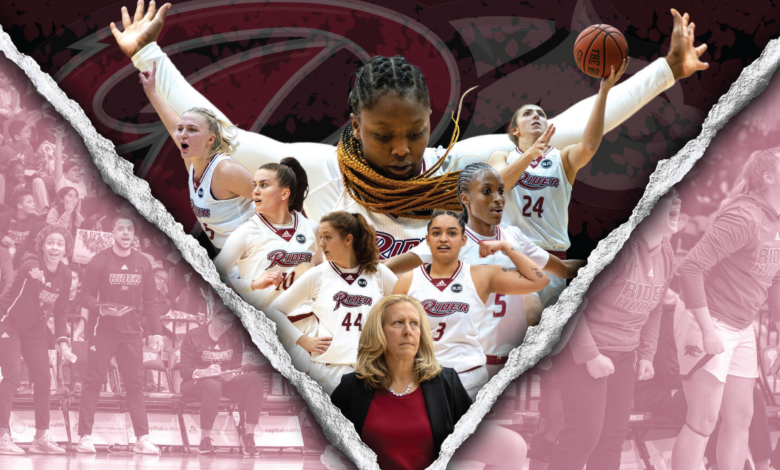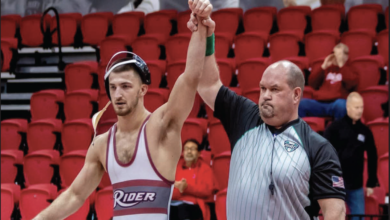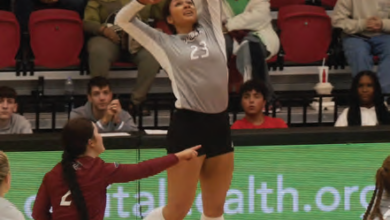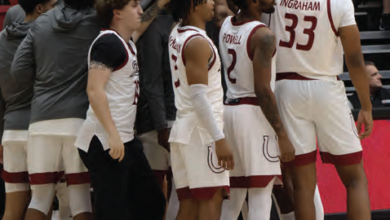
PREVIEW: Broncs emerge as MAAC Tournament dark horse
By Jake Tiger
After a 62-49 loss to Fairfield on Feb. 4, the team’s sixth straight, Rider women’s basketball plummeted to 2-11 in Metro Atlantic Athletic Conference (MAAC) play, its worst start since the 2015-16 season.
But between the Broncs’ bus ride home from Fairfield, Connecticut, and their next game on Feb. 9, something seemed to click.
The Broncs halted their losing streak with a pivotal, imposing win over Marist, and since then, they’ve managed to win three of their last five games by adopting a brand of fundamental, hard-nosed basketball.
A new offensive identity and improved defense have 5-13 Rider’s stock rising ahead of the MAAC Tournament, but questions of strength and legitimacy still impede the path to the ultimate goal.
Paint ball
For Rider, the beginning of MAAC play was defined by an inability to consistently hit and defend the 3-pointer.
While some of those issues persist, particularly on the defensive end, the Broncs have gradually shifted their focus away from the perimeter and toward the paint, playing an inside-out style of offense.
“We know what we want our identity to be,” said Milligan. “I think our players understand what makes us successful.”
This type of offense has proven to be more effective and consistent, forcing the Broncs into high-percentage shots under the rim, rather than relying on streaky outside shooting.
At 40.9%, the Broncs are fourth in the MAAC in field goal efficiency and are one of four teams shooting over 40%. In their 3-2 stretch, though, they have been even better.
Since Feb. 9, Rider’s new offensive mindset has earned it a field goal percentage of 43.9%, which would be second in the MAAC, and it has found 152 of its 301 points in the paint, just over half.
A major part of Rider’s renaissance in the paint has been junior forward Raphaela Toussaint, who’s post-scoring artistry has netted her 12 straight games with double-digit points.
“I think [Toussaint] is one of the toughest [players to guard] in the league,” said Milligan. “I think her versatility is terrific. She’s playing with confidence now. … She knows her teammates want to give [the ball] to her. I think her teammates are putting her in successful situations and she’s coming through.”
In that 12-game span, Toussaint is averaging 12.3 points and 6.9 rebounds per game and has posted double-doubles in three straight games.
“She always makes that big play,” said senior center Victoria Toomey of playing beside Toussaint. “We’ve been able to really build a high-low game. We’re pretty good at knowing where the other person is going to be without really seeing them.”
Toomey has been another beneficiary of the Broncs’ new scheme, seeing a noticeable uptick in her scoring. On the season, she’s averaging 8.7 points per game, but in her last five showings, Rider’s captain put up an average of 12.8 on 60.5% shooting.
Thanks in part to the dominance of Toomey and Toussaint, graduate student guard Amanda Mobley is still by far the best playmaker in the MAAC this season, according to the numbers. In her final season, she sits at the top of the conference in assists per game with 6.1 and total assists with 166 in 27 games.
The closest player to Mobley is Iona’s Ketsia Athias, who averages 4.9 assists per game and has 133 total assists in the same number of games.
“[Mobley’s] been with us when we’ve been at our highest and she’s been with us when we haven’t been the highest,” said Milligan. “She understands the grind of the MAAC better than anybody. She understands what it takes to win in the tournament.”
With some consistent contributors on offense, Rider is moving in the right direction and may be peaking at the perfect time, but the Broncs themselves are still far from perfect; they are 5-13 for a reason.
Unfinished, unproven
Perimeter defense remains the biggest crack in Rider’s armor, a season-long flaw and the culprit of numerous losses.
Conference opponents are shooting an average of 42.8% against the Broncs, the second-highest mark in the MAAC, and from three, opposing players are hitting a league-high 36.2% of their shots.
Rider hit rock bottom on Jan. 19 in a 90-62 loss to Iona, in which the Gaels shot 16-of-18 from three, the most efficient long-range shooting display in NCAA women’s basketball history.
“We’ve just been consistently inconsistent,” said Milligan. “We had games where we were giving up 80, 90 points, which is something traditionally we don’t do.”
In its 3-2 stretch, the Broncs have shown improvement, holding teams to 34.1% from beyond the arc, but that number would still place them last in the MAAC.
This stat is especially troublesome given the strength of Rider’s recent opponents, or lack thereof. The Broncs are yet to beat any of the MAAC’s top-six teams this season, all five of their wins coming against lesser competition.
But sixth-seeded Manhattan is next on the schedule, and with the Broncs playing their best basketball of the season, the matchup on March 2 could allow Rider to make a statement ahead of the MAAC Tournament.
Seeding scenarios
After Manhattan, Rider could be looking at back-to-back games with seventh-seeded Marist. The Broncs take on the Red Foxes for their regular season finale on March 4, and are slated for a rematch in the first round of the MAAC Tournament on March 7.
However, some key matchups in the final week of the regular season could shake things up.
As they have for most of the season, the Broncs (5-13) currently rank 10th in the MAAC, only ahead of winless Saint Peter’s (0-18) and just behind Canisius (6-12) and Mount St. Mary’s (6-12).
On March 2, Canisius and Mount St. Mary’s face off, giving Rider a chance to jump the loser in the standings and play the winner in the first round. Regardless of the opponent, a first-round victory in Atlantic City, New Jersey, is a real possibility for the Broncs, something they could not achieve last season.
A win in the quarter finals is far less likely for Rider, but the MAAC is no stranger to dark horses.
“We’ve had our ups and downs this season, there’s no question about that,” said Milligan. “I think it’s pretty obvious that we’re not where we want to be. But I think it’s [about] keeping your team and your players locked in on what the ultimate target is, where the ultimate destination is.”



